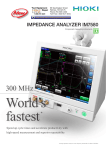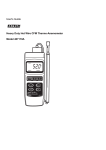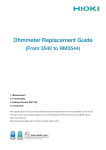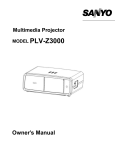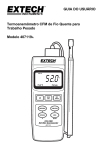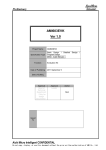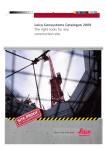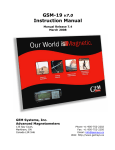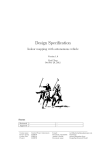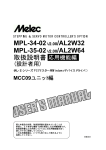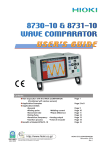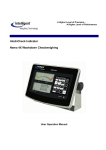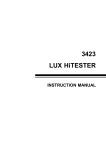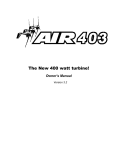Download IMPEDANCE ANALYZER IM7580
Transcript
IMPEDANCE ANALYZER IM7580 Component measuring instruments 300 MHz World’s fastest * Speed up cycle times and accelerate productivity with high-speed measurement and superior repeatability *Among impedance analyzers with a frequency bandwidth of 1 MHz to 300 MHz. 2 3 With a measurement time of 0.5 ms, the IM7580 is history’s fastest impedance analyzer. More than just fast Improved repeatability ensures stable measurement. Repeatability (Z, 3 CV) The IM7580 delivers the speed and precision that manufacturing applications demand. Repeatability and analog measurement times (Comparison of the IM7580 and the Hioki 3535) 1% Sample: 600 Ω Beads Measurement frequency: 100 MHz 1/10 the variability 0.1% Precision 0.046% 0.01% 3535 Faster speed IM7580 0.1 As fast as 0.5 ms 1 10 100 1000 Analog measurement time (index time) [ms] IM7580 basic specifications Basic accuracy ±0.72% rdg. Measurement speeds*1 FAST: 0.5 ms / MED: 0.9 ms / SLOW: 2.1 ms / SLOW2: 3.7 ms Measurable range 100 mΩ to 5 kΩ Measurement frequency 1 MHz to 300 MHz Measurement signal level -40.0 dBm to +7.0 dBm / 4 mV to 1,001 mV / 0.09 mA to 20.02 mA *1 Analog measurement time 4 268 mm (10.55 in) 215 mm (8.46 in) IM7580 external view 24 mm (0.94 in) 200 mm (7.87 in) 55 mm (2.17 in) 61 mm (2.40 in) Superior productivity in a small package Compact, half-rack footprint A test head that fits in the palm of your hand The ability to fit two instruments into a single rack and use them simultaneously lets you carry out a variety of measurements faster. This size is essential for boosting volume on production lines. The IM7580’s test head is small enough to fit in the palm of your hand, enabling it to be placed closer to the measurement target. The ability to position the test head next to the measured object makes testing less susceptible to noise and other adverse effects, increasing accuracy. Turntable Fixture Large display The display’s brightness, color, and text size can be changed according to the needs of your application, while the touch screen provides a convenient and intuitive user experience. Number of display digits (3/4/5/6) Absolute value display Customizable display color (Background color and display color) Customizable text size 5 1. GP-IB 2. RS-232C 3. EXT I/O (Handler interface) 4. LAN 5. USB (for PC connectivity) GP-IB INTERFACE Z3000 RS-232C INTERFACE Z3001 * The GP-IB and RS-232C INTERFACE are optional. Extensive range of interfaces for PC-based management Save measurement conditions and results on a USB flash drive Extensive range of interfaces for external control Use the USB slot on the front of the IM7580 to store measurement results, screens, and measurement conditions saved on the instrument’s internal memory on a USB flash drive. Use the IM7580’s LAN, USB, GP-IB, RS-232C, and EXT I/O interfaces to control the instrument from an external device. LAN *The GP-IB and RS-232C interfaces are optional. GP-IB (optional) EXT I/O Connector RJ-45 connector Connector 24-pin Transmission method 10Base-T, 100Base-Tx, 1000Base-T Standard IEEE 488.1 1987 Protocol TCP/IP Reference standard IEEE 488.2 1987 Terminator CR+LF, LF USB (for PC connectivity) RS-232C (optional) Connector USB Type B Connector D-sub 9-pin Electrical specifications USB 2.0 (High Speed) Flow control Software Transmission speed 9600 / 19200 / 38400 / 57600 bps Connector D-sub 37-pin Female #4-40 inch thread DC-37P-ULR (solder) Compatible connectors DCSP-JB37PR (crimp) Japan Aviation Electronics Industry, Ltd. *For more information, see page 15. 6 Dual measurement modes Featuring LCR Mode and Analyzer Mode LCR Mode Use LCR Mode to make measurements by applying the desired frequency and level signal to the component being measured. This mode is ideal for evaluating passive devices such as capacitors and coils. Comparator measurement: Yields a PASS/FAIL judgment for the target component based on a single judgment criterion. HI Upper limit Greater than or equal to upper limit HI is displayed. IN Reference value Within range defined by upper and lower limits IN is displayed. LO Lower limit Less than or equal to lower limit LO is displayed. Upper and lower limit judgment: Set the upper and lower limits. Percentage judgment:Set the upper and lower limits as percentages of the reference value. Deviation percentage judgment: Set the upper and lower limits as percentages of the reference value. The instrument will display deviation of the measured value from the reference value (Δ%). Bin measurement: Ranks components using multiple judgment criteria. BIN1 BIN2 BIN3 BIN4 IN BIN5 .... BIN10 Measurement standard range Set upper and lower limits for each bin. The instrument will rank components using up to 10 categories. *Upper and lower limit settings are the same as for comparator measurement. Display Zoom function Monitor function Displays measured values using larger text for better visibility on production lines and in other field applications. Displays the measurement signal level being applied to components in real time. Monitor voltage: 0.0 mV to 1000.0 mV Monitor current: 0.000 mA to 20.000 mA 7 Measurement parameters: Measure up to four parameters simultaneously. Z Impedance G Conductance Rp Equivalent parallel resistance Cp Equivalent parallel capacitance Y Admittance B Susceptance Ls Equivalent series inductance D Loss factor tan δ θ Phase angle Q Q-factor Lp Equivalent parallel inductance V Monitor voltage* X Reactance Rs Equivalent series resistance (ESR) Cs Equivalent series capacitance I Monitor current* *Analyzer mode only Analyzer Mode Use Analyzer Mode to perform measurement while sweeping through a range of measurement frequencies and measurement signal levels. This mode is ideal for checking frequency characteristics and level characteristics. Normal/segment sweep operation: Discover component characteristics by sweeping through a range of frequencies and levels. Normal Segment Sweep parameters Performs measurement after you set the sweep parameter (frequency or level), sweep range, number of sweep points, and measurement conditions. Allows you to set the sweep parameter, sweep range, number of sweep points, and measurement conditions on a segment-by-segment basis. Frequency/signal level (power, voltage, current) Sweep range 1 MHz to 300 MHz, -40.0 dBm to +7.0 dBm Number of sweep points/segments Up to 801 points / Up to 20 segments (with a total of 801 points) Measurement condition settings Frequency, level, speed, average Interval sweep operation: Discover element characteristics over time under set conditions. Measurement condition settings Frequency, level, speed, average Time interval 0 sec. to 1,000 sec. Number of sweep points/segments Up to 801 points / Up to 20 segments (with a total of 801 points) Display The graph display can be switched based on the type of measurement being performed (with a total of 7 layouts available). Sweep graph display (1-graph/4-graph display) XY graph display (1-graph/2-graph display) Multi-display (simultaneous display of sweep and XY) List display Peak display 8 Intelligent measurement and analysis Convenient functionality for performing measurement, reviewing measurement results, and judging measured values Analyzer Mode LCR Mode C A A B C B C B A: Panel numbers set for continuous measurement; B: Measured values; C: Parameter judgment results A: Cursor; B: Search result point; C: Measured values at result point Continuous measurement function Measured value search function Conduct continuous measurement by progressively loading multiple sets of previously saved measurement conditions using the panel save function. Measurements can combine LCR and Analyzer Mode measurement conditions. The cursor can be moved automatically to a user-selected measured value point for one set of sweep measurement results. Continuous measurement can be performed using up to 46 measurement condition combinations, and can be implemented from EXT I/O. Selecting an Analyzer Mode panel displays the waveform. Search options Maximum value Moves the cursor to the maximum value. Minimum value Moves the cursor to the minimum value. Target Moves the cursor to a user-set measured value. L-Max value Moves the cursor to the local maximum value (a filter can be set). L-Min value Moves the cursor to the local minimum value (a filter can be set). Select a measurement parameter to search for. Select the search type. (If target, enter the value.) Select whether to search for a rising waveform or falling waveform. Panel save and load function Save previously configured measurement conditions, compensation values, and compensation conditions in LCR or Analyzer Mode and load saved measurement conditions. Number of panels that can be saved LCR Mode measurement conditions 30 Analyzer Mode measurement conditions 16 Select whether to use a filter. (Local maximum and local minimum values only) Auto search function Move the cursor automatically according to user-configured settings once sweep measurement is complete. 9 A Area judgment screen A: Analysis results Peak judgment screen Area and peak comparison functions Equivalent circuit analysis function Check whether measured values fall inside a previously configured judgment area. These functions are ideal for use in verifying nondefective products. Analyze individual component values (L/C/R) for elements in the following five circuits based on measurement results: R1 C1 Area judgment: Obtaining an overall judgment for each sweep L1 L1 L1 Define a range by setting upper and lower limits and display the judgment results as IN or NG. C1 Peak judgment: Identifying resonance points Define a range by setting upper, lower, left, and right limits and display the judgment results as IN or NG. R1 R1 L1 IN judgment: Inside area NG judgment: Outside area R1 C1 L1 Judgment area C1 C1 R1 Simulation function/ residual error display Perform a simulation based on equivalent circuit analysis results and compare the results to measured values to verify their accuracy. The residual error display allows you to check the quantitative difference between measured values and simulation results. Judgment area Difference Z IN judgment: Inside area NG judgment: Outside area Measured values Simulated values Frequency 10 Absolute accuracy The IM7580 features the functionality you need to make accurate, reliable measurements. Contact check Compensation function The instrument checks the state of contact between the measurement terminals and circuit elements to verify the state of contact and detect contact errors. To truly measure accurately, all analyzers should first be set up to their optimal state. DCR measurement: Checking contact before Test head terminals (Calibration reference surface) and after measurement This capability is ideal for carrying out contact checks of inductive components with low DC resistance values such as inductors, ferrite cores, and common-mode filters. Judgments based on user-configured upper and lower contact resistance limits Guaranteed accuracy range 0.1 Ω to 100 Ω Measurement timing Before measurement, after measurement, or before and after measurement Measured value > Upper limit: Displays “HI.” Upper limit ≥ Measured value ≥ Lower limit: Displays “IN.” Measured value < Lower limit: Displays “LO.” Sample connection terminals (Calibration reference surface) Measurement sample 1 m cable (optional: 2 m) Connector/cable/test fixture Test head IM7580 Open, short, and load calibration Hi-Z reject function: Judging the contact state based on measurement results The compensation process involves calibrating the measurement setup, from the IM7580 to the reference surface (either the test head terminals or the sample connection terminals). Each of three standards (open, short, and load) is connected and its calibration data measured to eliminate potential sources of error. Activate this function in order to output a measurement terminal contact error if the impedance measured value is greater than a user-configured reference value. Electrical length compensation Valid setting range 1 Ω to 10000 Ω Enter the length of the electrical connection between the reference surface and the measurement sample connection surface to allow compensation of error caused by phase shift. Waveform judgment function: Detecting If mounting a fixture on the test head, it is necessary to enter the fixture’s electrical Verify that components and terminals are in contact during measurement. The instrument will output an error if fluctuations in the RMS value exceed a user-configured range that has been set using the initially acquired RMS value waveform as the reference value. Open and short compensation chatter during measurement Valid setting range 0.01% to 100.0% of the reference value Output format Screen error display or EXT I/O error output length. Open and short compensation eliminates sources of error from the calibration reference surface to the sample connection surface (including the fixture, measurement cables, etc.). 11 1 A TRIG B EOM EOM 2 Reset on ERR Reset off Previous Current Previous Current TRIG 3 EOM A Pulse A Delay B Previous ERR 4 Hold Current INDEX Signal External control I/O Key lock function When using external control, you can regulate the input and output signal timing as desired. You can lock the instrument’s keys to prevent erroneous or unauthorized screen operation. 1. Trigger input: Timing and enable/disable settings A.Choose to enable or disable trigger input during measurement. By disabling input, you can prevent erroneous input caused by chatter. Full key lock Disables all setting changes. Set key lock Enables only comparator and bin judgment settings. *Before activating the key lock function, check the passcode setting. B.Select whether to base input timing on the trigger’s rising edge or falling edge. 2. Reset Audio Signal judgment result You can set the timing at which judgment results are reset. On: Reset the previous judgment results at the measurement complete signal’s rising edge. Off:Reset the previous judgment results when the next judgment results are output. 3. Measurement complete signal: Output method and output delay A.Select whether to use pulse or hold output for the measurement complete signal. Pulse:You can set the duration for which the measurement complete signal is placed in the “on” state. Hold: The measurement complete signal switches from “on” to “off” at trigger input. B.You can set the duration of the delay from output of judgment results to output of the measurement complete signal. 4. Analog measurement Output delay signal: When using trigger-synchronized output, you can ensure that the analog measurement signal is only output once the measurement signal has turned off. Trigger-synchronized output: The measurement signal is only applied to the sample during measurement. You can turn the beep tone on or off based on the comparator judgment results. The key tone can also be turned on or off. Beep types: 14 Volume: 3 settings Warm-up function The instrument will display a message indicating that warm-up operation is complete about 60 minutes after it is powered on. (A warm-up period of 60 minutes is required in order for the instrument to perform at its defined accuracy.) 12 Applications Common-mode filter measurement Panel save and continuous measurement When one component must be measured two different ways or when compensation values and measurement conditions differ for each measurement point, the IM7580 streamlines the measurement process by automatically switching among compensation values and measurement conditions. When one component must be measured two different ways Automatic switching Common mode Differential mode Halve cycle times by using two instruments… Thanks to a compact design, two IM7580s can be stored in one rack. Using two impedance analyzers simultaneously can dramatically reduce cycle times. When compensation values and measurement conditions differ for each measurement point 4 3 2 1 Progressive switching of compensation values and measurement conditions 1→2→3→4 PASS/FAIL judgments for power inductors Comparator function By using the comparator function’s area and peak judgment functions, you can easily differentiate between defective and non-defective components. Set the judgment area and then check whether component measurement results fall inside that area. This approach is well suited to differentiating between defective and non-defective components. Non-defective: IN Defective: NG As illustrated to the left, you can set a range around the peak value and use it to make judgments. Area judgment 13 Measurement parameters and measurement conditions Z Y θ X G B Q Measurement parameters Display range Z Y θ X G B Q Impedance Admittance Phase angle Reactance Conductance Susceptance Q-factor Rs Rp Ls Lp Cs Cp D Equivalent series resistance (ESR) Equivalent parallel resistance Equivalent series inductance Equivalent parallel inductance Equivalent series capacitance Equivalent parallel capacitance Loss factor tan δ 0.00m to 9.99999G Ω 0.000n to 9.99999G S ±(0.000° to 999.999°) ±(0.00m to 9.99999G Ω) ±(0.000n to 9.99999G S) ±(0.000n to 9.99999G S) ±(0.00 to 9,999.99) Rs Rp Ls Lp Cs Cp D Δ% ±(0.00m to 9.99999G Ω) ±(0.00m to 9.99999G Ω) ±(0.00000n to 9.99999G H) ±(0.00000n to 9.99999G H) ±(90.00000p to 9.99999G F) ±(0.00000p to 9.99999G F) ±(0.00000 to 9.99999) ±(0.000 to 999.999%) Measurable range 100 mΩ to 5 kΩ Output impedance 50 Ω (at 10 MHz) Measurement frequency Measurement signal level Range 1 MHz to 300 MHz Resolution 1.0000 MHz to 9.9999 MHz: 100 Hz steps 10.000 MHz to 99.999 MHz: 1 kHz steps 100.00 MHz to 300.00 MHz: 10 kHz steps Accuracy ±0.01% of setting or less Range Power: -40.0 dBm to +7.0 dBm Voltage: 4 mV to 1,001 mV Current: 0.09 mA to 20.02 mA User-configured power, voltage, and current Resolution 0.1 dB steps Accuracy ±2 dB (23°C ±5°C) / ±4 dB (0°C to 40°C) Speed and accuracy Measurement speed (analog measurement) Averaging Basic accuracy Guaranteed accuracy range Guaranteed accuracy period Terminal design FAST MED : 0.5 ms : 0.9 ms SLOW SLOW2 : 2.1 ms : 3.7 ms Valid setting range: 1 to 256 (in steps of 1) Z: 0.72% rdg. θ: 0.41° 100 mΩ to 5 kΩ (impedance) 1 year 2-terminal design Supplementary functionality Trigger function Compensation function Contact check *1 User-selectable internal or external trigger (EXT I/O, interface, manual) Trigger delay: 0 sec. to 9 sec. Trigger-synchronized output: Stabilization wait time of 0 sec. to 9 sec. INDEX signal delay time of 0 sec. to 0.1 sec. Trigger types: Sequential, repeat, step*1 Open/short/load calibration: From IM7580 to test head Open/load compensation: Compensation of fixture component Electrical length compensation: 0 mm to 100 mm Correlation compensation: Compensation of display values based on user-input compensation coefficient DCR measurement, Hi-Z reject function, waveform judgment function Analyzer mode only Recording and interface Measurement modes Measurement modes LCR mode: Measurement using a single set of conditions Analyzer mode: Sweep measurement and equivalent circuit analysis Continuous measurement mode: Continuous measurement using previously saved conditions LCR mode Bin measurement: 10 categories for 4 measurement parameters Measurements Comparator measurement: Hi, IN, and Lo judgments for 4 parameters Functionality Monitor function Monitor voltage range: 0.0 mV to 1000.0 mV Monitor current range: 0.000 mA to 20.000 mA Display Zoom display function: Enlarged display of measured values Analyzer mode Measurements Functionality Display Display and sound Key lock function Beep tone Warm-up function Selection of number of display digits Display settings Sweep measurement Up to 801 sweep points with user-configurable point delay Normal sweep: Measurement of up to 801 points Segment sweep: Up to 20 segments (with a total of 801 points) Display Time interval measurement Interval of 0.00000 sec. to max. 1,000.00 sec., 801 points Other Equivalent circuit analysis: 5 circuit models Cursor function: Automatically search for maximum and minimum values, target, local maximum and minimum values Comparator function: Area and peak judgment List display graph display, XY graph display, judgment results display Scaling: Linear or logarithmic Continuous measurement mode Measurements LCR Mode: 32000 Number of measured Analyzer Mode: 100 sweeps values that can be Measured values are stored in the instrument and then saved stored in memory all together. Measurement conditions: 30 sets for LCR mode, 16 sets for Panel save and load Analyzer mode functions Compensation values only: 30 sets for LCR mode HANDLER, USB, LAN, GP-IB (optional), RS-232C Interfaces (optional) Continuous measurement using up to 46 combinations of the following measurement conditions: 30 LCR mode measurement conditions and 16 analyzer mode measurement conditions Operating temperature and humidity range Storage temperature and humidity range Operating environment Power supply and maximum rated power Dielectric strength Standards compliance Dimensions and weight Accessories Lock operation of the instrument using the panel. Unlock by entering a passcode. Enable or disable for judgment results and key operation. The instrument will display a message 60 minutes after it is powered on. 3, 4, 5, or 6 digits LCD display on/off Backlight brightness adjustment Measurement screen background color (white or black) Switchable parameter colors 8.4-inch color TFT with touch panel 0°C to 40°C, 20% RH to 80% RH, non-condensing -10°C to 50°C, 20% RH to 80% RH, non-condensing Use indoors at an elevation of 2,000 m or less in an environment with a maximum pollution level of 2. 100 V to 240 V AC (50/60 Hz), 70 VA 1.62 kV AC for 1 min. between power line and ground line EMC: EN 61326, EN 61000 Safety: EN 61010 Approx. 215 W × 200 H × 268 D mm (8.46 W × 7.87 H × 10.55 D in) , approx. 6.5 kg (229.3 oz) Test head ×1, Connection cable ×1, Power cord ×1, Instruction manual ×1, LCR application disc (Communications user manual) ×1 14 Measurement accuracy Z: ±(Ea + Eb) [%] θ: ±0.58 × (Ea + Eb) [°] Conditions Guaranteed accuracy temperature and humidity range 0°C to 40°C, 20% RH to 80% RH (non-condensing) However, must be within ±5°C of the temperature at the time of calibration. Guaranteed accuracy period 1 year (Open, short, and load calibration should be performed daily before measurement.) Warm-up time At least 60 min. Measurement conditions Frequency, power, and speed points at which open, short, and load calibration have been performed Ea = 0.5 + Er Er: For power of -7 dBm to +7 dBm Frequency FAST MED SLOW SLOW2 1 MHz to 100 Mhz 0.09 0.06 0.036 0.03 100.01 MHz to 300 MHz 0.108 0.078 0.039 0.036 Er: For power of -40 dBm to -7.1 dBm Eoff Frequency Er FAST MED SLOW SLOW2 1 MHz to 100 MHz 3 × 10 (-0.046P + Eoff) -1.8 -2 -2.15 -2.3 3 × 10 -1.75 -1.9 -2.1 -2.25 100.01 MHz to 300 MHz (-0.048P + Eoff) P: Power setting [dBm] ) Eb = ( Zs = ( 20 + Zsr + 0.5 × F ) [Ω] ( F: Measurement frequency [MHz] ) 1000 Zs + Yo· Zx Zx × 100 [%] ( Zx :Z measured value in [Ω]) Zsr: For power of -7 dBm to +7 dBm FAST MED SLOW SLOW2 13.5 9 5.1 3.9 Zsr: For power of -40 dBm to -7.1 dBm Zoff Zsr 3 × 10 (-0.048P + Eoff) FAST MED SLOW SLOW2 0.35 0.2 0 -0.15 P: Power setting [dBm] Yo = ( 30 + Yor + 0.15 × F ) [S] ( F: Measurement frequency [MHz] ) 1000000 Yor: For power of -7 dBm to +7 dBm FAST MED SLOW SLOW2 7.5 5.7 3.3 2.4 Yor: For power of -40 dBm to -7.1 dBm Zoff Yorr 3 × 10 (-0.046P + Yoff) FAST MED SLOW SLOW2 0.1 0 -0.2 -0.4 P: Power setting [dBm] Basic measurement confirmation table* Free software for calculating accuracy Z [Ω] 1000 100 10 0.8 % 1% 2% 5% 10 % 1 1 10 100 Measurement frequency [MHz] *For -7 dBm to +7 dBm, SLOW2. Free software for automatically calculating measurement accuracy based on user-entered measurement conditions and measurement results can be downloaded from Hioki’s website. 15 External control List of EXT I/O handler interface signals 19 18 17 16 15 14 13 12 11 10 9 8 7 6 5 4 3 Pin I/O 1 IN TRIG 2 IN Unused 3 IN Unused 4 IN LD1 5 IN LD3 TRIG External trigger 6 IN LD5 LD0 to LD6 Panel number selection 7 IN Unused 8 - ISO_5V EOM Measurement complete signal ISO_COM INDEX Analog measurement complete signal Detection level error 2 1 Signal 37 36 35 34 33 32 31 30 29 28 27 26 25 24 23 22 21 20 Signal Function 9 - 10 OUT ERR ERR 11 OUT PARA1-HI,BIN1,PARA1-NG LD_VALID Panel load 12 OUT PARA1-LO,BIN3,PARA2-NG 13 OUT PARA2-IN,BIN5,PARA3-NG ISO_5V Isolated power supply 5 V input 14 OUT AND,BIN7 ISO_COM Isolated power supply common Comparator judgment result: HI judgment 15 OUT PARA3-IN,BIN9,PARA4-IN PARA1-HI to PARA4-HI 16 OUT PARA4-HI PARA1-IN to PARA4-IN Comparator judgment result: IN judgment 17 OUT PARA4-LO 18 OUT Unused PARA1-LO to PARA4-LO Comparator judgment result: LO judgment 19 OUT OUT_OF_BINS,CIRCUIT_NG OUT_OF_BINS Bin measurement result 20 IN Unused BIN1-BIN10 Bin judgment allocation: Bin 1 to Bin 10 CIRCUIT_NG Equivalent circuit analysis: Comparator judgment result PARA1-NG to PARA4-NG Peak judgment result PARA1-IN to PARA3-IN Peak judgment result AND Result of applying a logical AND operation to judgment results for measured values for four parameters (output when all judgment results are IN) 21 IN Unused 22 IN LD0 23 IN LD2 24 IN LD4 25 IN LD6 26 IN LD_VALID ISO_COM 27 - 28 OUT EOM 29 OUT INDEX 30 OUT PARA1-IN,BIN2,PARA1-IN 31 OUT PARA2-HI,BIN4,PARA2-IN 32 OUT PARA2-LO,BIN6,PARA3-IN Connector used 33 OUT PARA3-HI,BIN8,PARA4-NG 34 OUT PARA3-LO,BIN10, 35 OUT PARA4-IN 36 OUT Unused 37 OUT Unused D-sub 37-pin Female #4-40 inch thread Input signals Electrical Output specifications signals DC-37P-ULR (solder) Compatible DCSP-JB37PR (crimp) connectors Japan Aviation Electronics Industry, Ltd. Photocoupler-isolated, no-voltage contact input Input “on” voltage: 0 V to 0.9 V / input “off” voltage: open or 5 V to 24 V Isolated NPN open collector output Maximum load voltage: 30 V / maximum output current: 50 mA/channel Residual voltage: 1 V or less (10 mA) or 1.5 V or less (50 mA) Built-in isolated Voltage: 4.5 V to 5 V / maximum output current: 100 mA power supply Floating relative to protective ground potential and measurement circuit Timing chart Example of LCR Mode measurement timing TRIG (Measurement start signal) EOM (Measurement complete signal) Chuck OFF ON ON ON Previous ERR judgment result (Error signal) OFF OFF TRIG (Measurement start signal) (Judgment result output) Judgment result LD_VALID LD0 to LD6 LD0 to LD6 *In this example, the TRIG signal’s active edge is the falling edge (ON). ON ON ON Previous ERR judgment result (Error signal) LD_VALID Chuck OFF ON INDEX (Analog measurement complete signal) ON Open Chuck Connection state EOM (Measurement complete signal) ON INDEX (Analog measurement complete signal) (Judgment result output) Open Chuck Connection state Example of Analyzer Mode measurement timing OFF ON Judgment result EOM: Off from trigger input to end of measurement processing INDEX: Off during probe chuck (probe cannot be removed from target) OFF Instrument IMPEDANCE ANALYZER IM7580 IMPEDANCE ANALYZER IM7580-02 Standard accessories*1 • Test head • Connection cable (IM7580: 1 m / IM7580-02: 2m) • Instruction manual • LCR application disc (Communications user manual) • Power cord Free software for calculating accuracy (LCR application disc) Free software for automatically calculating measurement accuracy based on user-entered measurement conditions and measurement results can be downloaded from Hioki’s website. *1 The instrument does not ship with a test fixture or probe. A test fixture designed specifically for use with the Impedance Analyzer IM7580 is required. For more information, please contact your Hioki distributor. Options Interfaces GP-IB INTERFACE Z3000 GP-IB CONNECTION CABLE 9151-02 Cable length: 2 m (6.56 ft) RS-232C INTERFACE Z3001 RS-232C CABLE 9637 Cable length: 1.8 m (5.91ft) Any interlink-compatible cross-cable can be used as the RS-232C CABLE. Test fixtures and associated options: Available in December 2014 (tentative) • TEST FIXTURE STAND IM9200 • ADAPTER IM9906 (3.5 mm to 7 mm) • SMD TEST FIXTURE IM9201 Note: Company names and Product names appearing in this catalog are trademarks or registered trademarks of various companies. HIOKI (Shanghai) SALES & TRADING CO., LTD.: TEL +86-21-63910090 FAX +86-21-63910360 http://www.hioki.cn / E-mail: [email protected] DISTRIBUTED BY HIOKI INDIA PRIVATE LIMITED: TEL +91-124-6590210 FAX +91-124-6460113 HEADQUARTERS: E-mail: [email protected] 81 Koizumi, Ueda, Nagano, 386-1192, Japan TEL +81-268-28-0562 FAX +81-268-28-0568 HIOKI SINGAPORE PTE. LTD.: http://www.hioki.com / E-mail: [email protected] TEL +65-6634-7677 FAX +65-6634-7477 E-mail: [email protected] HIOKI USA CORPORATION: HIOKI KOREA CO., LTD.: TEL +1-609-409-9109 FAX +1-609-409-9108 TEL +82-42-936-1281 FAX +82-42-936-1284 http://www.hiokiusa.com / E-mail: [email protected] E-mail: [email protected] All information correct as of Sept. 10, 2014. All specifications are subject to change without notice. IM7580E2-49B Printed in Japan
















